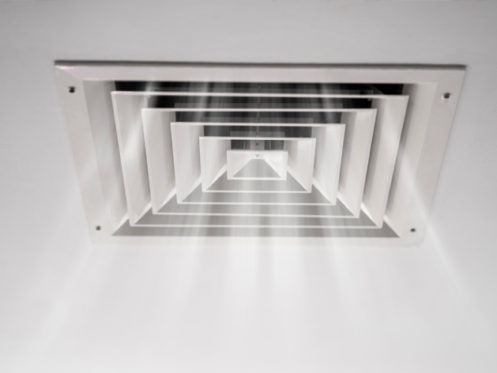If you’re concerned about the indoor air quality (IAQ) of your St. Louis, MO home, you’re not alone. Homeowners are fast realizing the shortcomings of HVAC air filters when it comes to removing common contaminants. Many airborne particles pass right through these components and are repeatedly cycled in the home. Incorporating air purification into your home heating and cooling plan will create a cleaner, fresher-smelling, and all-around healthier living environment. However, the key to optimizing these benefits lies in choosing the right air purifier type. To make an informed choice, it is essential to see how portable, freestanding air purifiers measure up to integrated, whole-house air purification.
What Is a Portable Air Purifier?
The air filters in your HVAC system are largely designed to protect your heating and cooling equipment. These components trap airborne debris before they have the chance to settle on coils and other sensitive components inside of your air conditioner or furnace. Although air filters limit the amount of dust and debris floating around your home, they provide limited IAQ benefits overall. If you have people in your household with chronic respiratory conditions or if they are constantly wheezing, sneezing, and dealing with other unpleasant symptoms while the HVAC system is on, portable air purifiers offer a cost-effective way to improve your IAQ.
These simple, freestanding units are plugged directly into wall outlets, and they operate independently of your HVAC system’s components. High-end portable air purifiers can remove smaller particles that frequently pass through the mesh of standard HVAC air filters. Many of these purification units have powerful, high-efficiency particulate air (HEPA) filters that capture and retain particles measuring 0.3 microns or larger. These include dust, dander, bacteria, mold, and pollen. With their reasonable prices, portable air purifiers can effectively supplement basic HVAC air filtration to create cleaner air within small, contained areas.
However, the power and effectiveness of any portable air filter is limited to a single room. The clean air delivery rate (CADR) of these units is relative to the maximum amount of space that they’re designed to service. Thus, if you set up a portable air filter in your bedroom or living room, airborne contaminants in all other spaces will be left unchecked. If you want air purification throughout the whole house, you’ll have to set up a portable air purifier in every room. Moreover, portable air purification systems cannot eliminate odors or trapped fragments in HVAC ducting, and they may be responsible for producing ozone emissions.
What Is a Whole-House Air Purification System?
Whole-house air purifiers are integrated HVAC accessories. These units are installed directly in HVAC air ducts, just before or right after air handlers. Unlike portable air purifiers, these units work in tandem with heating and cooling equipment, and they’re always active when furnaces or air conditioners are running. You cannot operate a whole-house air purifier independently of your heating and cooling system, but you don’t have to worry about managing its functions. Once your purifier is installed, you can run your HVAC system like you normally do, and you’ll automatically enjoy noticeable improvements in your IAQ.
Whole-house air purifiers continually eliminate airborne particles in every room of the home. They also extract odors and debris from HVAC air ducts. The indoor air is constantly cycled through these units and micro-fine contaminants that bypass standard HVAC air filters are captured and retained. Whole-house air purifiers can even come with enhanced capabilities due to built-in UV lights for sanitization or photocatalytic oxidation that turns harmful particulate matter into water and detritus.
Air purifiers that are installed directly in HVAC ducting often address a much broader range of airborne contaminants than portable, freestanding units do. In addition to mold and certain forms of bacteria, some whole-house purifiers can eliminate viruses, volatile organic compounds (VOCs), and more. These options can frequently remove particulates as fine as the aerosols that are released during a sneeze.
How Different Options in Air Purification Affect Your HVAC Equipment
Air purification and air filtration are not one and the same. Air filters extract small-sized particulates and air purifiers essentially clean the indoor air with micro-fine particulate extraction and sanitization. This distinction is especially clear in whole-house air purifiers that leverage UV lights or use photocatalytic oxidation.
Your standard HVAC air filter likely has a maximum efficiency reporting value (MERV) rating that falls between five and eight. Higher MERV ratings inhibit airflow due to closely-knit filter mesh, but they also mean that a larger number of particulates are extracted. You can upgrade your HVAC air filter to one with a MERV rating as high as 12, but you may see decreases in heater and air conditioner efficiency when doing so, and you won’t get the same IAQ improvements that you will if using a whole-house air purifier instead.
Freestanding, portable air purifiers have no impact on HVAC system stress. They don’t impede airflow throughout these systems at all. Moreover, if you have multiple, high-quality portable units throughout your home, your portable air purifiers may even improve the efficiency of your HVAC system by reducing the amount of micro-fine debris that it must contend with. However, this is only possible when portable air purifiers are well-maintained and used for six or more hours each day.
Even when integrated, whole-house air purifiers contain HEPA filters with MERV ratings of 17 or greater, they’re unlikely to negatively impact HVAC equipment. This is because these integrated accessories and the ductwork that contains them are streamlined to work seamlessly together during installation. Thus, whole-house air purifiers provide the greatest indoor air quality gains even as they consistently have a positive impact on heating and cooling equipment. A whole-house air purifier will auto-engage whenever the HVAC system is on, and it will continuously reduce the volume of micro-fine, airborne particulates floating around your home and settling on internal HVAC components. All-in-all, although they’re a bit pricier than portable models, whole-house air purifiers are the most worthwhile solution.
Maintaining Your Air Purifier
When comparing whole-house air purifiers to portable models, you must account for maintenance. Although lifespans vary significantly across different air purifier types and based upon how frequently these units are used, whole-house purifiers tend to last a lot longer than portable models. Moreover, there’s a lot less hands-on maintenance that homeowners must perform. Integrated, whole-house air purifiers must be maintained entirely by HVAC technicians. This maintenance is often handled during annual HVAC ductwork inspections or when air conditioners and heaters receive their yearly tune-ups. Comparatively, the maintenance for portable models falls entirely in the hands of homeowners.
Since 2004, we’ve been proudly serving residents of the greater St. Louis, MO area. We offer furnace, air conditioner, and heat pump service. We also provide cutting-edge IAQ solutions and preventative HVAC maintenance plans. If you’re ready to give your home’s IAQ a noticeable boost, contact Agers Heating & Air Conditioning today!




